- Scientific name: Platanthera orbiculata
- Species of Greatest Conservation Need (MA State Wildlife Action Plan)
- Threatened (MA Endangered Species Act)
Description
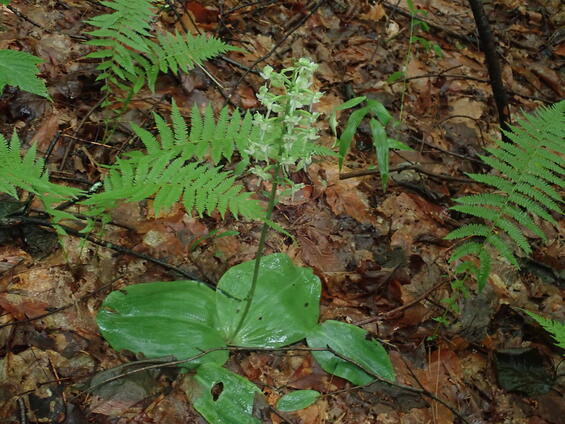
Platanthera orbiculata plant in bloom. Photo by Lynn Harper.
Round-leaved orchid, Platanthera orbiculata, is a perennial plant of the orchid family (orchidaceae) found in moist woods and bogs. It is one of three species of Platanthera orchids in this genus that have paired round, glossy basal leaves and, without the flowers, can be very difficult to determine to species. This includes round-leaved orchid (P. orbiculata), large round-leaved orchid (P. macrophylla), and Hooker’s orchid (P. hookeri). All three are glabrous (have no hairs) plants and may occur in similar habitats. Unfortunately, these round-leaved orchids do not always flower each year, complicating their identification. However, all three species are now listed and protected under the Massachusetts Endangered Species Act. The two “round-leaved orchids” also have similar flowers that need floral parts to be measured carefully to determine which species has been observed. Hooker’s orchid has distinctive flowers that cannot be confused with the two round-leaved orchids.
Round-leaved orchid is similar to large round-leaved orchid (P. macrophylla). Both are perennial wildflowers of moist woods or bogs and have variously been lumped as one species with two varieties and as two species. Round-leaved orchid is slightly smaller with two opposite, shiny, basal leaves lying on the ground, ranging in size from 5-10 cm (3-4 in) The flowers are in a raceme and the petals range from white to greenish-brown. It has a linear, elongated labellum (lower petal) with an unusually long nectar spur, mostly 20-27 mm (0.79-1.1 in) in length, which extends out behind the flower, and pollinarium are 3-4.5 mm (0.12-0.18 in) in length. Haines 2011 gives this description of measurements to determine large round-leaved orchid, the “spur length plus twice the pollinarium length [is] equal to or greater than 38.” If those measurements are less than 38, the plant is round-leaved orchid, P. orbiculata. The flowering scapes have 1 to 6 small bracts on the flowering stem. The plants can produce over 30 showy flowers.
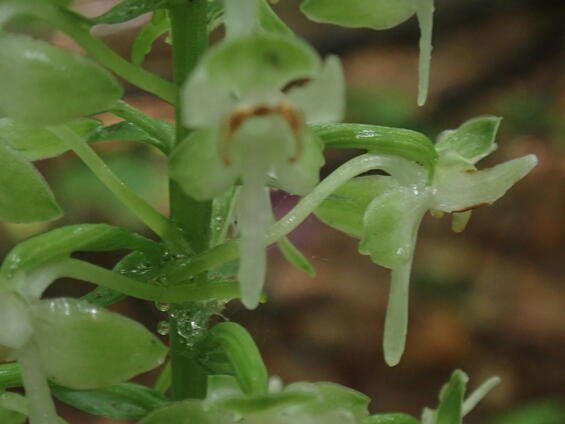
Platanthera orbiculata close of flowers. Photos by Lynn Harper.
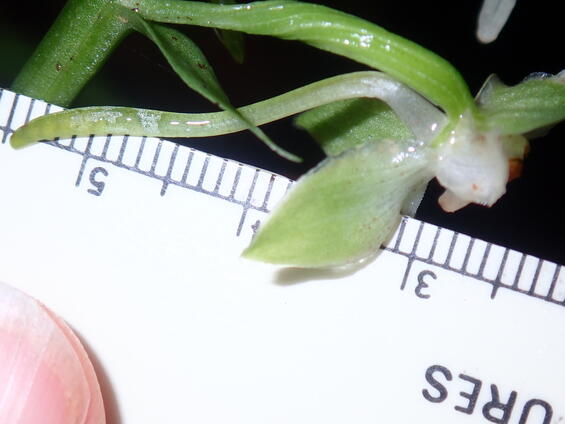
Platanthera orbiculata measuring the spur.
Life cycle and behavior
Round-leaved orchid paired leaves will emerge during May. The flowering stalk will push up soon after and it will be in bloom from the last week of June through the beginning of August. Round-leaved orchid is pollinated by a wider variety of pollinators than large round-leaved orchid. The pollinators will have at least one pollinium stick to them to be carried to and deposited at another flower. The seed capsules are held upright and will be mature by fall, releasing thousands of wind-distributed seeds less than 2 mm (0.08 in) in size. Only a few seeds are likely to land in an appropriate habitat, they then will need to be infected by acceptable mycorrhizal fungi before they can germinate and form an underground protocorm. Cleavitt et al. 2016 described 5 life stages of the two round-leaved orchids:
- “underground germinant/protocorm;
- above-ground juvenile with a single linear leaf (at least 2:1 in length–width);
- an immature stage with a single round leaf;
- vegetative adult with two rounded leaves; and
- flowering adult with two rounded basal leaves and a raceme.”
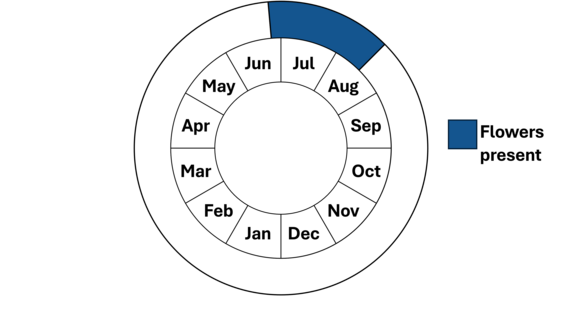
Population status
In Massachusetts, round-leaved orchid is listed under the Massachusetts Endangered Species Act as threatened. All listed species are protected from killing, collecting, possessing, or sale and from activities that would destroy habitat and thus directly or indirectly cause mortality or disrupt critical behaviors. There are currently 11 occurrences in the state verified since 1999 found in Berkshire, Franklin, and Hampden Counties. There are several historical occurrences, though most do not have accurate locational information, but it is known that it occurred in Dukes, Essex, Middlesex, and Plymouth County as well as the western counties listed above.
Distribution and abundance
Round-leaved orchid range that extends across Canada from Newfoundland to Alaska south to South Carolina and Oregon. Although considered secure globally, many states and Canadian provinces considered this species vulnerable throughout most of its range. In New England, it is considered state historic in both Connecticut and Rhode Island, imperiled in Massachusetts and Vermont; and it isn’t ranked in Maine or New Hampshire.
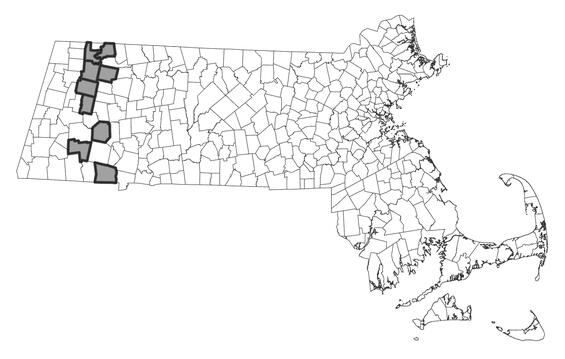
Distribution in Massachusetts.1999-2024. Based on records in the Natural Heritage Database
Habitat
This is a species of forests, often near headwaters, small streams or in wetland margins, though with a wider range of elevations and requiring a lower mineral enrichment than its congener, P. macrophylla. This plant grows in rich, deciduous or mixed mature woodlands. The white flowers are lightly fragrant and conspicuous at night and are thought to be pollinated by night-flying moths. Associated species include beech (Fagus grandifolia), hemlock (Tsuga canadensis), yellow birch (Betula alleghaniensis), red maple (Acer rubrum), sugar maple (A. saccharum), black cherry (Prunus serotina), maple-leaved viburnum (Viburnum acerifolium), white ash (Fraxinus americana), hobblebush (Viburnum lantanoides), cucumber root (Medeola virginiana), round-leaved violet (Viola rotundifolia), sessile-leaved bellwort (Uvularia sessilifolia), and eastern hay-scented fern (Dennstaedtia punctilobula). The understory is typically sparse.
Healthy habitats are vital for supporting native wildlife and plants. Explore habitats and learn about conservation and restoration in Massachusetts.
Threats
The primary threats to round-leaved orchid are not well known. Deer browse of flowering spikes and leaves may destroy a population. As this plant is often found in areas with little ground cover, densely growing invasive plant species are a threat. Fire suppression has been noted as a possible threat in parts of its range. Increases in shading due to canopy closure may be a problem, though Reddoch and Reddoch (1997) note that these orchids disappeared after logging and after beaver removed trees adjacent to plants. Changes in hydrology and trampling are also possible threats in Massachusetts. Anything that damages or destroys its pollinators or the mycorrhizal fungus it depends on also threatens this species. Over a larger view of the species, it is suspected that climate change (Staudinger et al. 2024) with warmer temperatures and more erratic rainfall patterns is also impacting this species negatively as it has decreased substantially to the south of Massachusetts.
Conservation
Survey and monitoring
As with all rare plant species, regular monitoring is important to assess the health of the populations. Orchids can be particularly difficult to monitor as they bloom, or even show on the surface, only when the conditions are “right.” The population may have apparent swings in numbers observed from one year to the next, even though the numbers of plants may be relatively stable. If large round-leaved orchid is not observed one year, it does not mean that the plant is not present. The best time to survey for this species is when it is in bloom from late June to early August. It is important to survey when flowers are present so that the species may be confirmed. If one surveys the plants and finds them in bud, you can return to survey them in flower. If you survey and find the flowers past, a survey can’t be completed until the following year to identify the orchid species. Each plant is a separate genet.
Management
The management needs of large round-leaved orchid are not known. As a woodland species, some shade is probably needed, however too much is thought to be a problem. As with many orchids, some disturbance is needed. Protection from deer and other animal browse is likely to be needed and may include fencing of some type. All active management of rare plant populations (including invasive species removal) is subject to review under the Massachusetts Endangered Species Act and should be planned in close consultation with the MassWildlife’s Natural Heritage & Endangered Species Program.
Research needs
Several recent papers have documented dramatic and significant declines in New England's native orchid species (Bertin et al.2022, Bertin 2013, MacKenzie et al. 2019). Known or putative causes of decline include, but are not limited to, deer herbivory (Knapp and Wiegand 2014, Berry and Cleavitt 2021), earthworms (McCormick et al.2023), lack of disturbance (Sheviak 1990), nitrogen deposition altering soil pH (Figura et al.202A), and canopy closure (Brumback et al. 2011, Whigham et al.202l), all of which affect orchids in Massachusetts. Other specific threats include changes in climate.
Habitat loss is also likely the cause for a decrease in the population in eastern Massachusetts. An increase in invasive plant species which shade plants is also a threat. Genetic research on these closely related orchid species is also needed.
References
Berry, EJ and NL Cleavitt QAZD Population dynamics and comparative demographics in sympatric populations of the round-leaved orchids Platanthera mocropltylla and P. orbiculata. Population Ecology. 63 (4),274-289. https://doi.org/10,3159/TORREY-D-13-00039.1
Brackley, F.E. 1985. The orchids of New Hampshire. Rhodora 87(849): 1-117.
Brumback WE, Cairns S, Sperduto MB, Fyler CW (2011) Response of an Isotria medeoloides Population to Canopy Thinning. Northeastern Naturalist 18:185–196. https://doi.org/10.1656/045.018.0205
Cleavitt, Natalie L., Eric Berry, Jill Hautaniemi and Timothy J. Fahey. Life stages, demographic rates and leaf damage for the round-leaved orchids, Platanthera orbiculata (Pursh.) Lindley and P. macrophylla (Goldie) P.M. Brown in a northern hardwood forest in New Hampshire, USA. Botany 95: 61-71 (2016) dx.doi.org/10.1139/cjb-2016-0164
Figura T, Weiser M, Ponert J (2020) orchid seed sensitivity to nitrate reflects habitat preferences and soil nitrate content. Plant Biology 22:21–29. https://doi.org/10.1111/plb.13044
Frost, Karro. 2023. Species listing proposal for Platanthera orbiculata. Massachusetts Natural Heritage & Endangered Species. Massachusetts Division of Fisheries and Wildlife, Westborough, MA.
Gleason, H.A., and A. Cronquist. 1991. Manual of Vascular Plants of Northeastern United States and Adjacent Canada, Second Edition. The New York Botanical Garden, Bronx, New York.
Haines, A. 2011. Flora Novae Angliae – a Manual for the Identification of Native and Naturalized Higher Vascular Plants of New England. New England Wildflower Society, Yale Univ. Press, New Haven, CT.
Hornbeck, J.H., C.H. Sieg, D.J. Reyer, and D.J. Bacon. 2003. Conservation Assessment for the Large round-leaved orchid in the Black Hills National Forest, South Dakota and Wyoming. United States Department of Agriculture, Forest Service, Custer, SD.
Knapp WM, Wiegand R (2014) orchid (orchidaceae) decline in the Catoctin Mountains, Frederick County, Maryland as documented by a long-term dataset. Biodivers Conserv 23:1965–1976. https://doi.org/10.1007/s10531-014-0698-2
McCormick MK, Parker KL, Szlavecz K, Whigham DF (2013) Native and exotic earthworms affect orchid seed loss. AoB PLANTS 5:plt018. https://doi.org/10.1093/aobpla/plt018
Native Plant Trust. 2014. NORM Phenology Information.
NatureServe. 2025. NatureServe Network Biodiversity Location Data accessed through NatureServe Explorer [web application]. NatureServe, Arlington, Virginia. Available https://explorer.natureserve.org/. Accessed: 3/25/2025.
POWO (2025). Plants of the World Online. Facilitated by the Royal Botanic Gardens, Kew. Published on the Internet; https://powo.science.kew.org/ Accessed: 3/25/2025.
Reddoch, A.H., and J.M. Reddoch. 1997. The orchids in the Ottawa District. The Canadian Field-Naturalist 111(1).
Sheviak CJ (1990) Biological considerations in the management of temperate terrestrial orchid habitats. New York State Museum Bulletin 471:194–196
Sheviak, C.J. 2003. Platanthera in Flora of North America. Editorial Committee, editors. Flora of North America, Volume 26 Page 555. Oxford University Press, New York, New York.
Smith, Welby R. 2012. Native orchids of Minnesota. University of Minnesota Press, Minneapolis MN.
Staudinger, M.D., A.V. Karmalkar, K. Terwilliger, K. Burgio, A. Lubeck, H. Higgins, T. Rice, T.L. Morelli, A. D'Amato. 2024. A regional synthesis of climate data to inform the 2025 State Wildlife Action Plans in the Northeast U.S. DOI Northeast Climate Adaptation Science Center Cooperator Report. 406 p. https://doi.org/10.21429/t352-9q86
Whigham D, McCormick M, Brooks H, et al (2021) Isotria medeoloides, a North American Threatened orchid: Fungal Abundance May Be as Important as Light in Species Management. Plants 10:1924. https://doi.org/10.3390/plants10091924
Contact
| Date published: | May 2, 2025 |
|---|